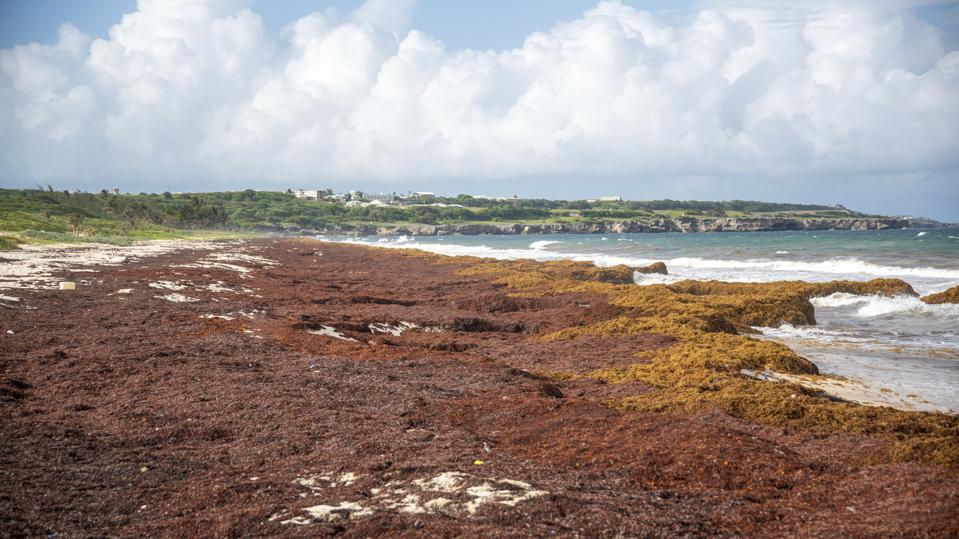Topline
Officials in Florida are preparing for a 5,000-mile floating island of seaweed called the sargassum belt to make its way on shore, where it’s expected to become both a nuisance and a health hazard as it rots.
Key Facts
That belt of sargassum, which is estimated to weigh more than six million tons, doubled in size from December to January, Florida Atlantic University oceanographer Brian Lapointe told CNN, and is expected to hit Florida and the Caribbean earlier this year than expected, with algae already spotted within a mile of Martinique and Key Largo, Florida.
The belt, which spans nearly the width of the Atlantic Ocean and would fill roughly 3,000 Olympic-sized swimming pools, is made of sargassum, a brown algae that forms gas-filled “berry-like structures” called pneumatocysts that act as pockets to keep the strands of algae afloat to receive sunlight.
According to data from the University of South Florida, the amount of sargassum in the Atlantic last month was the second most ever recorded in the month of February.
Officials in Florida are preparing for the sargassum belt to wash ashore on Florida’s Atlantic and Gulf coasts this summer, where it will decompose, creating a stench as it releases hydrogen sulfide into the air.
Ajit Subramaniam, an oceanographer at Columbia University, told PBS the belt acts as an “upside down coral reef” for ocean life—providing shelter and creating a “hotspot for biological diversity”—and can serve an ecological benefit to fish, turtles and birds that rely on it as food and offshore habitat, according to the National Oceanic and Atmospheric Administration, though the piles of rotting sargassum that eventually make it on shore have also proven to be a potential health hazard for humans.
Contra
A 2021 study published in Clinical Toxicology linked a 2018 sargassum stranding in the Caribbean to neurological, digestive and respiratory disorders, stemming from exposure to hydrogen sulfide released while the algae rots on the beach. Researchers also credited sargassum strandings in Barbados, Martinique, Puerto Rico and the Virgin Islands for an increase in “potentially fatal hypoxic pulmonary, neurological and cardiovascular legions” from exposure to hydrogen sulfide, according to a 2018 study in The Lancet. After another stranding last summer, officials in the U.S. Virgin Islands declared a state of emergency.
What To Watch For
The sargassum is also expected to enter the Gulf of Mexico through the Caribbean current before circling back to Florida’s Gulf Coast, where officials in Pensacola are planning to bury it under sand dunes if it exceeds normal amounts, the Pensacola News Journal reported. Storms in the Atlantic can also disrupt its path, bringing swaths of the algae up the East Coast on the Gulf Stream, making it as far as New England, where Maria Mitchell Association Aquarium Director Jack Dubinsky said it carries tropical fish that wouldn’t typically come into colder waters.
Key Background
Historically, the sargassum belt has occurred naturally in a remote section of the North Atlantic referred to as the Sargasso Sea, though scientists say it drastically expanded its geographic range around 2010, with strands being found as far east as Gibraltar, Morocco and Liberia, and as far west as the Gulf of Mexico and Caribbean Sea, according to NOAA. Researchers believe it advanced so far due to strong winds that shifted southward “more dramatically and persistently” than any other point over the past 100 years, before getting caught in several currents, stretching it from West Africa to the Caribbean. Other researchers hypothesize its expansion could be the result of changing nutrient levels stemming from agriculture in the Amazon River basin and warmer water temperatures.
Further Reading
A 5,000-mile-long mass of seaweed is coming to shore. Here’s what will happen (PBS)
Escambia, Santa Rosa ready for 5,000-mile-wide sargassum blob moving toward Florida (Pensacola News Journal)
A 5,000-mile seaweed belt is headed toward Florida (Associated Press)

